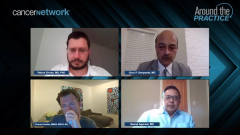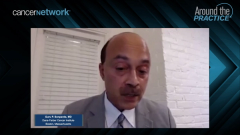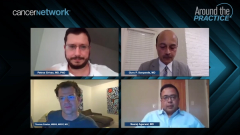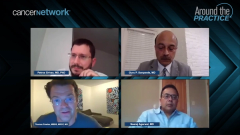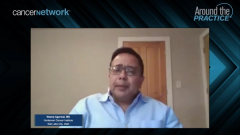
Clinical Impact of Biomarkers on Advanced Urothelial Cancer
Petros Grivas, MD, PhD; Guru P. Sonpavde, MD; Thomas Powles, MBBS, MRCP, MD; and Neeraj Agarwal, MD, comment on the role of biomarker testing and its impact on the patient selection and approach to treatment for advanced urothelial carcinoma.
Episodes in this series

Petros Grivas, MD, PhD: We have 4 minutes left, and I have 3 questions I want to cover quickly. I can tackle the first 1: Are there any data on platinum derivatives like oxaliplatin without toxicity profiles? The short answer is we do not use…carboplatin data. There was a study by Dr [Matthew] Galsky on cisplatin and whether this can be used for cell death. Practically speaking, these are interesting studies, but cisplatin or carboplatin is being used in practice, and as we mentioned, in the freelance setting. There are other questions about biomarkers. Tom, maybe you can take this 1, and then I’ll ask near Neeraj the other question. Concerning other biomarkers such as TMB [tumor mutational burden], MSI [microsatellite instability] status, maybe not pathway, do you have any comments on this and any other biomarkers?
Thomas Powles, MBBS, MRCP, MD: I’ll be very quick. The PD-L1 story has been unsuccessful. TMB has followed close behind it. We haven’t done prospective randomized trials with alpha allocation based on TMB. Retrospective analysis suggests it’s about the same place as PD-L1. It works in some trials but not all because we set different cut points and have different methods of measuring it. Sometimes it works, sometimes less so. It’s promising but not tested properly. There are other biomarkers, gene expressions, and T effector signatures that are well broadcast. There are a number that we’ve used. They all look promising but haven’t been tested formally. Then there are exploratory biomarkers. In TGFB, angiogenesis, a notch-signaling associated resistance, natural killer cells, macrophage expression, and other parts of the innate immunity appear promising. There are 2 things I’d like to say. Circulating tumor DNA [ctDNA] looks like an exciting biomarker, and that’s relevant. There’s a new thing called tertiary lymphoid structures, which essentially are our globes of active immunity. They may be more relevant than the single expression of a CDA cell being present or absent. We’re making progress with biomarker research. The first thing we need to do is drop some of the things that aren’t working before we move on to those that are.
Petros Grivas, MD, PhD: Thank you, Tom. That’s a fantastic overview. I just got notified that people are enjoying the discussion here, so we got a time extension, which is great. I can ask more questions to all of you. Tom, you covered nicely the biomarker data presented from the JAVELIN Bladder 100 trial. That publication is hopefully coming out soon. Also, there are data from Dr [Srikala] Sridhar that were presented at ASCO [American Society of Clinical Oncology Annual Meeting] 2020. If you had to design a future trial and use some of the biomarkers to select integral or integrated biomarkers—I know you’ll be working with CT—would you use your high-priority biomarker to evaluate the clinical utility?
Thomas Powles, MBBS, MRCP, MD: In the metastatic setting, I’d be trying to incorporate platforms of biomarkers and circulating biomarkers in tissue-based biomarkers, and pull them together. Let’s say there are tertiary lymphoid structures associated with immune checkpoint inhibitors, with ctDNA positivity, that would be relevant for me in that setting. Are there other biomarkers that are super interesting? There have been attempts to make biomarker platforms—TGFB, PD-L1, TMB—pile them all on top of one another. It doesn’t seem to improve accuracy. To some extent, we’ve come as far as we can with tissue-based biomarkers. Other people say to me, what about single-cell RNA sequencing? That’s more of a research tool than something we’re going use in the clinic in the future. First, we have to move away from PD-L1. We can do that successfully. Tertiary lymphoid structures to mutational burden and circulating tumor DNA are all 3 things for the future.
Petros Grivas, MD, PhD: Thank you, Tom. This is a wonderful discussion. You’re opening on a very interesting project, looking at biomarkers and learning to come up with biomarker discovery and validation. Who would like to comment on this biomarker question? Then, I’ll ask Guru something else.
Guru P. Sonpavde, MD: Because it’s a such a gray area, other than FGFR, alterations predicting an associated response to erdafitinib and possibly other FGFR inhibitors, I don’t see any role for biomarkers in my clinical use. I do use comprehensive genomic profiling for all patients who come to me for the first time—with metastatic bladder cancer, or for that matter any advanced cancer—because I know they’re not going to be responding to their treatments for too long. I don’t want to miss the opportunity to enroll them on a clinical trial. But beyond that, I don’t see any utility of biomarkers.
Petros Grivas, MD, PhD: Thank you so much. It’s very exciting work. Also, what we try to do is validate biomarkers, which are always the holy grail. It’s so difficult to validate biomarkers across clinical trials. We’re doing a good job with discovery. The biomedical question is still evolving.
Transcript edited for clarity.
Newsletter
Stay up to date on recent advances in the multidisciplinary approach to cancer.




